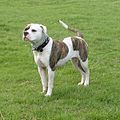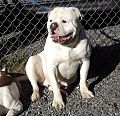American Bulldog
| American Bulldog | |||||||||||||||||||||||||||||||||
|---|---|---|---|---|---|---|---|---|---|---|---|---|---|---|---|---|---|---|---|---|---|---|---|---|---|---|---|---|---|---|---|---|---|
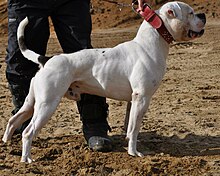 American Bulldog | |||||||||||||||||||||||||||||||||
| Other names | Southern White White English Old Southern White Bulldog Hill Bulldog Country Bulldog English White Bulldog | ||||||||||||||||||||||||||||||||
| Origin | United States | ||||||||||||||||||||||||||||||||
| |||||||||||||||||||||||||||||||||
| |||||||||||||||||||||||||||||||||
| Dog (domestic dog) | |||||||||||||||||||||||||||||||||
The American Bulldog is a large breed of utility dog[1] descended from the Old English Bulldog.[3] They are now used on animal farms, dog sports, and for showing. They are part of American culture and history, and may be used as a cultural icon for the United States.[citation needed] They are generally represented as being strong and tough. In November 2019, the American Bulldog was added to the American Kennel Club (AKC) Foundation Stock Service (FSS).[4][5]
History[]

The Old English Bulldog was preserved by working class immigrants who brought their working dogs with them to the American South; these dogs are believed to have first appeared as early as the 17th century. Small farmers and ranchers used this all-around working dog for many tasks including farm guardians, stock dogs and catch dogs. These dogs were not an actual breed as considered by today's standards and neither were most other dogs: kennel clubs of any kind did not yet exist and would not until 1875,[6] at least two centuries after the Old English Bulldog first migrated to America. In the 17th and 18th century, the Old English Bulldog had many different strains for cattle-droving, bull-baiting, farm dogs, and butcher's dogs.[7][8][9] Bull-baiting was also a common blood sport of the era and though there is evidence of such migrating to America with the landrace bulldogs brought by working class Englishmen in colonial times, it is also certain that the strains that migrated to America were unaffected by the banning of the sport in 1835 in the U.K. and, therefore, there was no need for a decline in the population of the old-type bulldog.
In America, there are no records but rather acknowledged landrace strains that initially depended on where a dog's master originated in England, the majority of which were bred to work as evidenced by accounts of the age in local newspapers and written inventories upon death. Later, breeding decisions were dependent on the best working farm dogs, despite breed or background. Later, in states like Texas, several separate strains of the "bulldog"-type dogs were kept by ranchers as utilitarian working dogs. Other dogs in time became guard dogs on plantations.[10]
Perhaps the most important role of the American Bulldog and the reason for its survival, and in fact why it thrived throughout the South, was because of the presence of feral pigs, introduced to the New World and without predators. The bulldogs were the settlers' only means of sufficiently dealing with the vermin.
By World War II, the breed was near extinction until John D. Johnson scoured the back roads of the South looking for the best specimens to revive the breed. During this time, a young Alan Scott grew an interest in Johnson's dogs and began to work with him on the revitalization process.[3][11][12][13] At some point, Scott began infusing non-Johnson catch bulldogs from working Southern farms with Johnson's lines, creating what is now known as the Standard type American Bulldog, also called the Scott type. At another point, Johnson began crossing his original lines with an atavistic English bulldog from the North that had maintained its genetic athletic vigor, creating the Bully type American Bulldog, also known as the Johnson type or the Classic type.
American Bulldogs are now safe from extinction and their popularity has increased in their homeland, either as a working/protector dog, as a family pet, or both. All over the world, they are used variously as "hog dogs" (catching escaped pigs or hunting razorbacks), as cattle drovers, and as working or sport K-9s. American Bulldogs also successfully compete in several dog sports such as dog obedience, Schutzhund, French Ring, Mondioring, Iron Dog competition and weight pulling. They are also exhibited in conformation shows in the UKC, NKC, ABA, ABRA, ORKC, EKC. The AKC added the American Bulldog to the FSS on November 11, 2019.[14]
Appearance[]
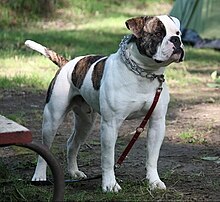
The American Bulldog is a stocky, well built, strong-looking dog, with a large head and a muscular build. The shoulders and chest tend to be the most muscular parts of the American Bulldog. Its coat is short and generally smooth, requiring little maintenance except a bath every few weeks. The breed is a light to moderate shedder. Colors, while historically predominantly white with patches of red, black, or brindle, have grown in recent years to include many color patterns including black, red, brown, fawn, and all shades of brindle. The color conformation is quite varied, but solid black or any degree of merle is considered a cosmetic fault, and a blue color is a disqualification by the National Kennel Club Breed Standard.[1] Black pigmentation on the nose and eye rims is traditionally preferred, with only some pink allowed. Eye color is usually brown, but heterochromia also occurs, although this is also considered a cosmetic fault. American Bulldogs are known to drool more than other breeds of dog. The Bully type is generally a larger, heavier dog with a shorter muzzle, but the muzzle should never be so short that it causes difficulty with breathing. Standard types are generally more athletic with longer muzzles and a more square head. Many modern American Bulldogs are a combination of the two types, usually termed "hybrid." In general, American Bulldogs weigh between 27 and 54 kg (60 to 120 lb) and are 52 to 70 cm (20 to 28 in) at the withers, but have been known to greatly exceed these dimensions, especially in the "out of standard," nonworking stock.
Temperament and characteristics[]
This section contains instructions, advice, or how-to content. (August 2020) |

American Bulldogs are typically confident, social, ebullient and lively dogs that are at ease with their families.[15] They bond strongly with their owners, and are happiest when their masters can shower them with time and attention. They are not as friendly, however, with people they do not know: their ancestors were farm dogs who guarded the home, the livestock, and the kids when their master was away.[16] They mature later than many other breeds, not until the age of two, and as puppies they will be curious yet aloof with strangers, but confident at maturity.[17]
Socialization of this breed is paramount: this breed should never be left alone, bored, in a house or garage day after day, as it may become chronically fearful and aggressive towards things it does not know or understand. This is a large breed that must not become a frog in a well that only knows its home territory and it must be trained out of the dog immediately if the dog is obtained past the age of 18 months.
American Bulldogs are a known breed that will destroy furniture and shoes if they are not given enough to do and this is yet another reason too much isolation is disastrous for this breed.[5] Fear- or aggression-causing triggers can include other dogs, children it does not know, postal workers, and strangers.[18] An American Bulldog does not trust anyone at first sight and must learn from its master what is a threat and what is not, and a dog of this breed must learn when to be territorial and when everything is okay.[19] In this facet its temperament is similar to other longer established and better-known utility breeds used for livestock guarding, like the Rottweiler, itself a German type of "bulldog"; another name for the breed being "Rottweiler Metzgerhund," or "butcher's dog from Rottweil".[20]
With children, socialization from the time the dog is brought home is a must.[21] True aggression towards babies and young children is rare and not characteristic of how the breed is meant to behave at all-this is a breed that ordinarily likes children; so long as it has had time to get to know them well it is more likely to play with the kids than hurt them. In fact, this breed can be very tolerant of a child's grabby hands that tug on its ears and can be a very devoted fellow mischief maker to the young ones in his family; the American Bulldog has a playful, impish streak when well-raised, well-bred, well-loved. and well-rounded.[22] Owners of this breed ideally will understand that this is a high-octane, powerful, headstrong breed and they shall be very careful to set limitations and rules for their dog and reinforce obedience training throughout the dog's life. They will not be first-time owners of a dog and shall be firm, but fair – harsh and violent methods will not work in training this breed, as it will only backfire and make the dog shut down, stubbornly refusing to listen to any further commands and making it angrier and angrier.[23][24] They will have access to places where the dog can exercise and run, but the owner will not take off the leash unless an area is enclosed with a high fence.
Unlike most other bulldog breeds, they are competent swimmers. That said, they do not have the affinity for water a retriever would: they swim if they have to do it, not because they particularly enjoy it.[25] They are capable of jumping in excess of 3 feet (0.91 m) vertically due to the dense muscle build of the breed and they love to run, jump, tackle and cavort. Lively, muddy games of rugby, Frisbee, American football, or lacrosse are rough-and-tumble games that this breed would adore, since it loves to roughhouse and will be thrilled to be included in a game with the children or help a teenager practice for the big game. A tall fence is a must to keep an American Bulldog from wandering off on an adventure and forgetting how to get home, so a microchip is highly recommended. Young American Bulldogs under the age of three years in particular love to bounce around and may accidentally knock over a toddler, a senior citizen, or a small child, so handling this breed on a leash is not recommended if one is a small child or an elderly adult, since the breed loves to pull and tug and may run away with those not strong enough to hold it.
They can do well with other dogs in the household or who visit regularly when properly introduced and supervised, preferably on neutral ground for the first few meetings so the American Bulldog in question can learn that this new dog has come to play, not to hurt his beloved family and home.[26][27] They are not necessarily good with strange dogs, especially in chaotic environments like the dog park. The more exposure to good training practices and clear behavior expectations with other dogs and people, the more likely the success at being controlled both inside and outside of their environment and the natural physically strong and powerful nature of the breed can be channeled positively.
Ongoing training both in the home and outside of the home is essential for this breed. While the goal of the breed was originally to produce a working farm utility dog that could catch and hold wild boar and cattle, kill vermin, and guard an owner's property, when properly trained, exercised, and socialized, this breed can become a very loyal, clownish family pet who loves to play and join the family on outings.[28]
It also doubles as a fine boarhound, and in its homeland it is often both a pet and a hunter at the same time: Southern Americans prize this breed as a courageous canine warrior in a Kevlar vest that will pin down an angry feral hog and defend the customary pack of hounds and the gunman from the hog's tusks. However, they also prize the breed having a soft, affectionate inner nature that can easily transition away from the hunt to a nice warm bath, a round of playing with the children, and have a well earned nap on its bed after getting a belly full of the barbecued wild hog ribs as a treasured member of the family.[29][30] As a working breed, they are good on pigs as catch dogs and decent on cattle: they stand their ground when challenged by an angry steer and still retain the herding instinct.[31][32] Overall, the American Bulldog is a breed that truly falls in love with his family and will do anything to keep it safe if the dog correctly senses danger up to, and including, risking its life to save them.[33][34]
Health[]
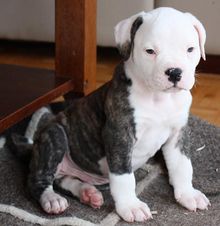
American Bulldogs generally live from 10 to 16 years, and tend to be strong, physically active, and often healthy. Some health problems in American bulldogs are often found within certain genetic lines, and are not common to the entire breed, while others, such as neuronal ceroid lipofuscinosis (NCL),[35] Ichthyosis, disorders of the kidney and thyroid, ACL tears, hip dysplasia, cherry eye, elbow dysplasia, entropion, ectropion, and bone cancer are more common to the general population of American Bulldogs. There are DNA tests available to help breeders screen breeding animals for NCL (neuronal ceroid lipofuscinosis)[35] and Ichthyosis. A Penn Hip (Pennsylvania Hip Improvement project) or OFA (Orthopedic Foundation for Animals) screening is recommended for all potential breeding animals. Some American Bulldogs are prone to allergies. Due to the ideal of beauty regarding the shape of the face the skull malformation brachycephaly was increased by breeding selection.
American Bulldogs in popular culture[]
- Spike and Tyke from the Tom and Jerry franchise
- The Deftones' video Bloody Cape featured a model walking an American Bulldog down the street. The American Bulldog was actually played by two separate dogs from the Norcal's American Bulldog Kennel. The names of the dogs were Big Trouble and Tory Hesta.
- In Return to Me (2000), David Duchovny's character's dog, Mel, is played by an American Bulldog named Peetey.
- In the 2001 film Kevin of the North, one of Kevin Manley's sled dogs is an American Bulldog named Snowflake.
- Nedd ("Nasty Evil Dead Dog") in The Number 23 (2007)
- In Tucker and Dale vs Evil (2010), Jangers, Tyler Labine's character's dog, is played by an American Bulldog named Weezer.
- An American Bulldog features prominently as the titular character's companion in the 2013 film Joe.
- The company logo for Zynga also featured an American Bulldog and was named after Mark Pincus' dog "Zinga".
- Since the 1990s, American Bulldogs have become more frequently used in films as family pets, replacing the previously popular American Pit Bull Terriers and Bull Terriers.[36] For example:
- Chance from the feature film Homeward Bound: The Incredible Journey (1993) and its sequel, Homeward Bound II: Lost in San Francisco (1996). Suregrips Rattler (Chance) was only in the first Homeward Bound movie. The first film based on The Incredible Journey featured a Bull Terrier.
- Although the original Petey from Hal Roach's Our Gang was an American Pit Bull Terrier, in the 1994 film remake The Little Rascals, Petey was played by an American Bulldog.
- In Cheaper by the Dozen (2003) and Cheaper by the Dozen 2 (2005), an American Bulldog named Gunner is the family pet.
Gallery[]
See also[]
- Dogs portal
- List of dog breeds
- American Bulldog Association
- American Bully
- Bulldog type
- Catch dog
- Molossus
- Old English Bulldog
References[]
- ^ a b c d "NKC American Bulldog Breed Standard". Nationalkennelclub.com.
- ^ Maggitti, Phil (October 1, 2018). Bulldogs. Barron's Educational Series. ISBN 9780764196539. Retrieved October 1, 2018 – via Google Books.
- ^ a b "DECLARATION of FACTS" (PDF). Dogsbite.org. Retrieved September 29, 2018.
- ^ "FSS News & Updates – American Kennel Club". American Kennel Club. November 11, 2019. Retrieved November 15, 2019.
- ^ a b "Stop Dog Chewing – My 11 month old American Bulldog from humane society keeps chewing and showing destructive behavior | Pet Health Library | PawDiet". www.pawdiet.com.
- ^ "History of the Kennel Club". www.thekennelclub.org.uk.
- ^ Merret, Christopher (1666). Pinax Rerum Naturalium Britannicarum, continens Vegetabilia, Animalia, et Fossilia. p. 169.
- ^ "Bulldog: Get The Low Down On This Breed | CanineJournal.com". June 1, 2016.
- ^ "The History Of Bulldogs". June 28, 2019.
- ^ "American Bulldog Dog Breed Information – Continental Kennel Club".
- ^ DK (October 17, 2013). The Dog Encyclopedia: The Definitive Visual Guide. Dorling Kindersley Limited. ISBN 9781409350026 – via Google Books.
- ^ Harris, David (July 24, 2012). The Bully Breeds. i5 Publishing. ISBN 9781621870326 – via Google Books.
- ^ Manfield, Mark (February 1, 2017). American Bulldog Bible And the American Bulldog: Your Perfect American Bulldog Guide Covers American Bulldog Puppies, Mini Bulldogs, American Bulldog Training, Johnson Bulldog, And More!. DYM Worldwide Publishers. ISBN 9781911355458 – via Google Books.
- ^ "FSS News & Updates – American Kennel Club". American Kennel Club. November 12, 2017. Retrieved November 15, 2019.
- ^ Mehus-Roe, Kristin (October 4, 2011). Original Dog Bible: The Definitive Source for All Things Dog. i5 Publishing. ISBN 9781935484899. Retrieved October 1, 2018 – via Google Books.
- ^ "American Bulldog Facts".
- ^ "American Bulldog Maturity".
- ^ "How to Socialize".
- ^ "Bulldogworld".
- ^ "Rottweiler". Purina.
- ^ "Ten things to know about purchasing an American Bulldog". November 13, 2015.
- ^ "American Bulldog". May 15, 2013.
- ^ "American Bulldog".
- ^ "American Bulldog: Complete Breed Profile". Dog Breeds Expert. Retrieved March 3, 2020.
- ^ "American Bulldogs Frequent Asked Questions About the Breed -".
- ^ https://pet-u.net/2017/06/how-to-introduce-dogs-for-a-peaceful-outcome/
- ^ "r/Dogtraining – Introducing a puppy to my American Bulldog". reddit. August 10, 2012.
- ^ Manfield, Mark (February 1, 2017). American Bulldog Bible And the American Bulldog: Your Perfect American Bulldog Guide Covers American Bulldog Puppies, Mini Bulldogs, American Bulldog Training, Johnson Bulldog, And More!. DYM Worldwide Publishers. ISBN 9781911355458. Retrieved October 1, 2018 – via Google Books.
- ^ "Hog Dogs: The Best Breeds for Hog Hunting". Wide Open Spaces. October 22, 2018.
- ^ McEldowney, Mykal. "Wild hogs put hunters to the test". The Greenville News.
- ^ www.woodyacresranch.com http://www.woodyacresranch.com/dogs/american-bulldog/. Retrieved March 3, 2020. Missing or empty
|title=(help) - ^ "Bulldog herding cattle". Archived from the original on December 21, 2021.
- ^ "Heroic American Bulldog Saves His Family". September 13, 2012.
- ^ "Heroic bulldog saves family's lives by keeping murderer at bay". April 17, 2015.
- ^ a b "NCL description for American Bulldogs". Caninegeneticdiseases.net.
- ^ "American Bulldog Movies – Reel Dogs". Reeldogs.com. April 20, 2015. Retrieved September 29, 2018.
External links[]
| Wikimedia Commons has media related to American Bulldog. |
- Bulldog breeds
- Catch dogs
- Dog breeds originating in the United States






